Mexico and Turkey had gross national incomes (GNI) of less than $10,000 per capita in 2019, according to the World Bank. Mexico’s GNI per capita was twice Turkey’s in 2002, fell behind Turkish GNI after 2008, and was slightly less in 2019, when GNI per capita was $9,430 in Mexico and $9,610 in Turkey. Mexico’s GNI per capita rose 50 percent in the first two decades of the 20th century, while Turkey’s GNI per capita more than doubled.
Mexico and Turkey had similar GNIs per capita of $9,500 in 2019
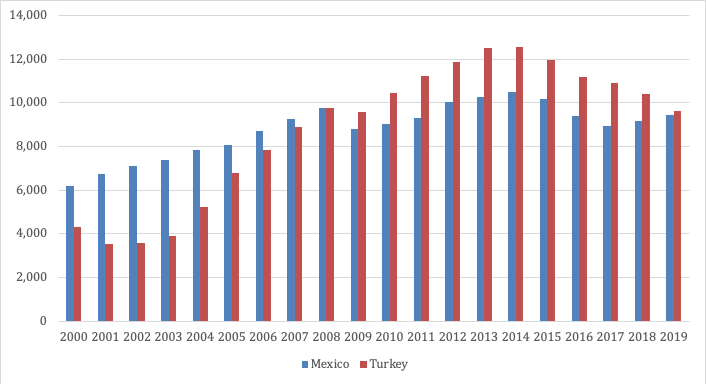
In 2000, 39 percent of employment in Turkey was in agriculture, according to the World Bank, more than twice the 17 percent share of employment in agriculture in Mexico. Employment in agriculture fell in both countries, but decreased faster in Turkey, so that 13 percent of Mexico’s employment, and 18 percent of Turkey’s employment, was in agriculture in 2019.
Employment in agriculture declined faster in Turkey than in Mexico from 2000 to 2019 (ag % of total employment)
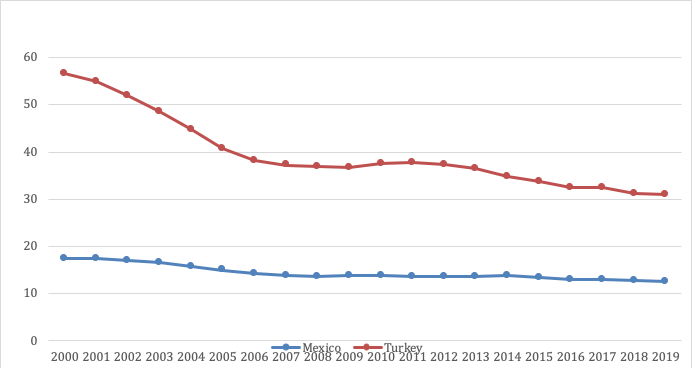
OECD data distinguish between total employment in agriculture and wage and salary employees in agriculture. The share of employees in Mexican agriculture rose from 38 percent in 2010 to 46 percent in 2019, while the share of employees in Turkish agriculture was stable at 10 percent.
The share of employees in agricultural employment is four times higher in Mexico than in Turkey (employee % of ag employment)
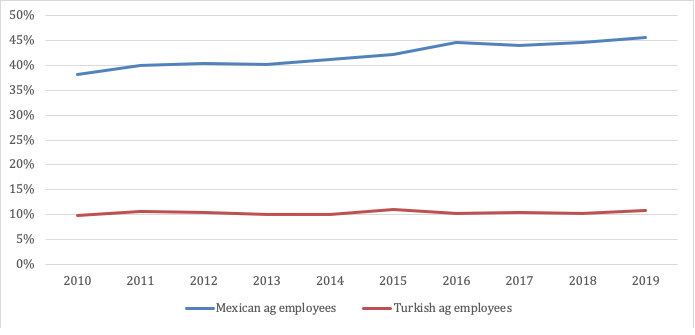
Vulnerable employment, defined by the World Bank as the share of self-employed and unpaid family workers in total employment, was higher in Turkey than in Mexico in 2000. Vulnerable employment fell faster in Turkey, so that the share of vulnerable in total employment was 27 percent in both countries in 2019.
Vulnerable employment is higher in Turkey but fell faster than in Mexico (% of total employment)
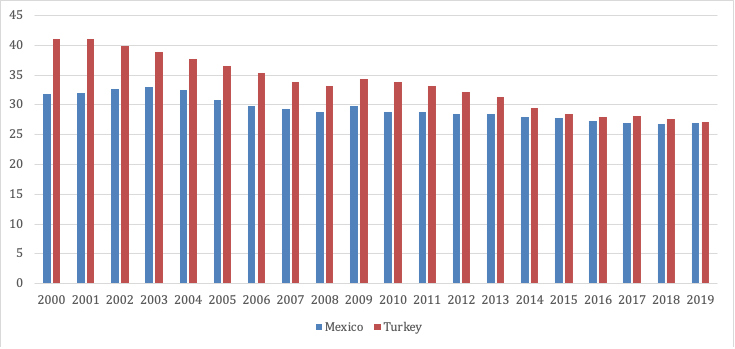
Mexico’s 31 states and Mexico City can be divided into six states that export a high share of the farm commodities they produce to the US, Baja California, Guanajuato, Jalisco Michoacán, Sinaloa, and Sonora, and 26 that do not export most of the farm commodities they produce. The six export states had over 720,000 hired farm workers in 2019, while 26 states that produce mostly for the domestic market had 1.6 million farm workers.
Farms in the 6 states that export high shares of commodities to the US have a third of Mexican hired farm workers
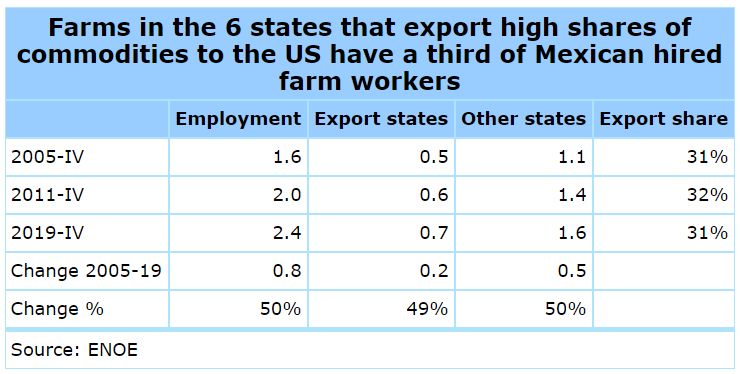
The median age of all hired farm workers in Mexico, according to the quarterly ENOE labor force survey, was 36 in 2019, and rose by two years between 2005 and 2019. Hired farm workers were younger in export states.
Hired farm workers are younger in the 6 export states than in other states
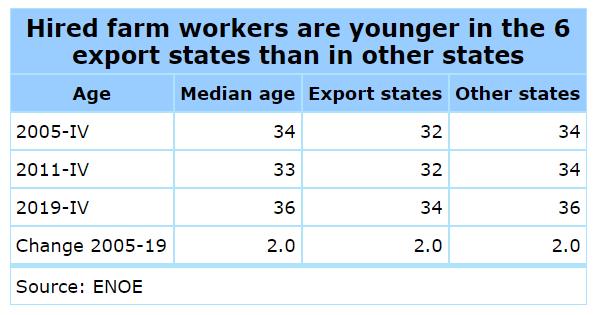
There was no difference in the median years of schooling of hired farm workers between export and non-export states; both had a median six years of schooling in 2011 and 2019. Median education rose by a year in non-export states between 2005 and 2011.
Hired farm workers had a median 6 years of schooling in all states
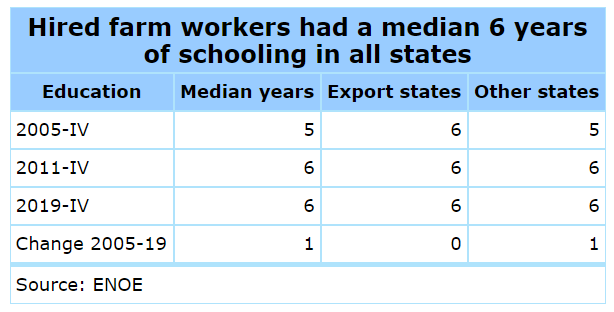
Mean wages for farm workers in Mexico were 3,400 pesos or $196 a month in 2019, and 25 percent higher in export states, 4,700 pesos, than in other states, 3,400 pesos. Wages fell five percent between 2005 and 2011, and more in export states than in non-export states. Farm worker wages rose 18 percent between 2011 and 2019, and slightly faster in export states.
The mean monthly wages of hired farm workers are 25% higher in export states
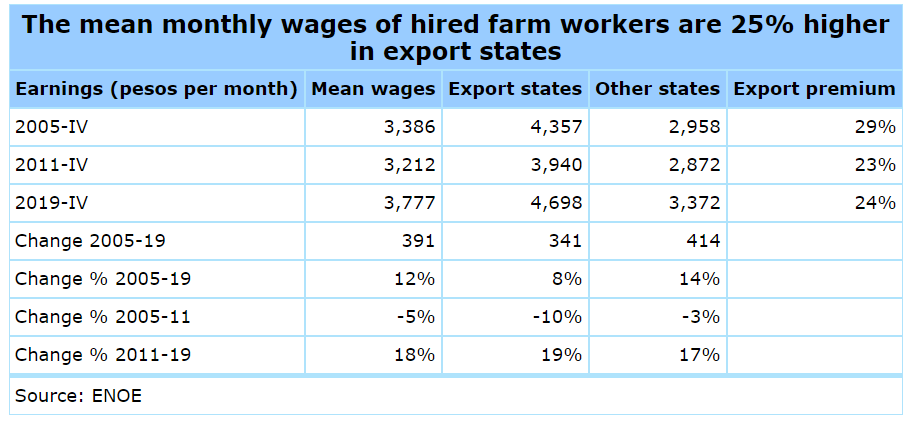
Author


Mexico Institute
The Mexico Institute seeks to improve understanding, communication, and cooperation between Mexico and the United States by promoting original research, encouraging public discussion, and proposing policy options for enhancing the bilateral relationship. A binational Advisory Board, chaired by Luis Téllez and Earl Anthony Wayne, oversees the work of the Mexico Institute. Read more

Explore More
Browse Insights & Analysis
Farm Labor & Rural Migration News Blogs

Farm Labor and Mexico's Export Produce Industry

Water Security at the US-Mexico Border | Part 1: Background


